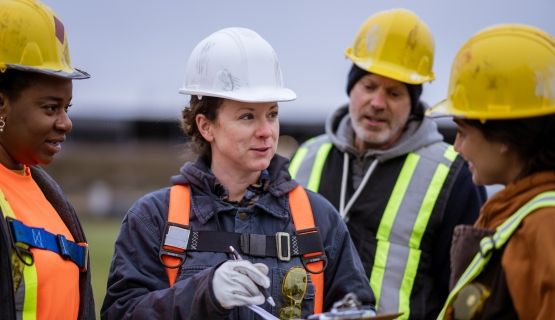Illness/injury prevention
IWH has a long history of conducting research to provide practical guidance to employers, workers, OHS professionals and regulators about what works and what doesn’t in injury or illness prevention. This research targets the injury and illness prevention practices of workplaces, as well as the programs developed by governments, health and safety associations and others to support and motivate workplaces to adopt effective practices.
Featured

At Work article
Differences in firm-level AI use for health and safety
To what extent are Canadian workplaces using artificial intelligence (AI) to help support workers’ health and safety? And what do these workplaces have in common? An IWH study surveyed firms across Ontario and British Columbia to find out.
Published: October 8, 2025

Impact case study
Saskatchewan’s construction safety group uses IWH tool to improve safety culture
This case study details how the Saskatchewan Construction Safety Association (SCSA) members have been analyzing IWH-OPM scores to adjust their safety practices and how SCSA has been using the data to tailor their outreach.
Published: February 10, 2025
Project
Project
IWH Organizational Performance Metric: Developing and evaluating a simple workplace OHS tool
Status: Completed 2018

Sharing Best Evidence
Factors for success in participatory ergonomics
In participatory ergonomics (PE), a team works together to identify risks, and change tools, equipment and work processes to improve workplace conditions. PE programs can reduce work-related injuries to muscles, tendons, ligaments and other soft tissues. This systematic review identifies the factors that can increase the likelihood of a successful PE program in workplaces.
Published: January 2008
Systematic Review
Systematic Review
Process and implementation of participatory ergonomics interventions: a systematic review
In participatory ergonomics (PE), a team works together to identify risks and change tools, equipment and work processes to improve workplace conditions. PE interventions have been shown to reduce work-related injuries to muscles, tendons, ligaments and other soft tissues. What elements of a participatory ergonomic intervention can help ensure its success in workplaces? This systematic review report answers this important question.
Published: January 2008
Systematic Review
Systematic Review
Systematic review of injury/illness prevention and loss control programs
Injury/illness prevention and loss control programs help protect workers from injuries, meet regulatory requirements, reduce the negative effects of injuries and manage costs. An IWH systematic review on these programs found strong evidence supporting the effectiveness of disability management/return-to-work programs. Read about the reviews findings and recommendations in this report.
Published: December 2007
Systematic Review
Systematic Review
Systematic review of OHS interventions with economic evaluations: full report
Before employers invest in workplace health and safety interventions, they want to know the financial implications of their investment. The goal of this review was to explore whether such interventions are worthwhile from an economic point of view. To find an answer, the Institute for Work & Health conducted a systematic review of studies of workplace-based health and safety interventions that also had an economic analysis. This review, as outlined in this final report, sought to answer the following question: What is the credible evidence that incremental investment in health and safety is worth undertaking?
Published: July 2007
Systematic Review
Systematic Review
Systematic review of OHS interventions with economic evaluations: appendices
This report includes appendices to the systematic review of OHS interventions with economic evaluations.
Published: July 2007
At Work article
At Work article
Ontario’s Patient Lift Initiative: early findings
The Institute for Work & Health was selected to evaluate the impact of the Patient Lift Initiative funded by Ontario's Ministry of Health and Long-Term Care
Published: April 2007
At Work article
At Work article
Preventing injury in health-care workers
There are many programs designed to prevent MSDs in health-care workers. But are these programs all effective? And which ones are better? IWH recently completed a systematic review that aimed to answer these questions.
Published: April 2007
At Work article
At Work article
Ontario, BC show different declines in work injury rates
In both Ontario and British Columbia, work injury rates dropped between 1990 and 2001. However, B.C. generally showed less of a decrease. By comparing rates among provinces, we can see who is performing better and start to explore why rates differ.
Published: February 2007
Journal article
Journal article
Non-agricultural work injuries among youth: a systematic review
Published: American Journal of Preventive Medicine, February 2007